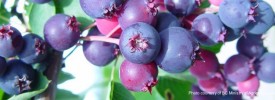 Cabbage is another nutritious and versatile Brassica vegetable that is easy to purchase locally. Cabbage thrives in cool weather climates, and is plentiful in the summer and through the fall. Well-stored cabbage can even last into the winter. There are three main types of cabbage: green, red and savoy. Each type has its own flavour, texture, and nutritional profile. Experiment with all varieties to find out which one you prefer.
Cabbage is another nutritious and versatile Brassica vegetable that is easy to purchase locally. Cabbage thrives in cool weather climates, and is plentiful in the summer and through the fall. Well-stored cabbage can even last into the winter. There are three main types of cabbage: green, red and savoy. Each type has its own flavour, texture, and nutritional profile. Experiment with all varieties to find out which one you prefer.
Nutrition
Cabbage is a very nutritious. It is an excellent source of vitamin K and vitamin C, and a very good source of fiber, manganese, folate, vitamin B6, potassium and omega-3 fatty acids. Glucosinolates found in cabbage are powerful anti-cancer compounds, and also help maintain a healthy digestive tract. Cabbage is also a powerful cholesterol reducer. All around, cabbage is just what the doctor ordered!
How to Select
Choose cabbage heads that are firm and dense with shiny, crisp, colorful leaves free of cracks, bruises, and blemishes. There should be only a few outer loose leaves attached to the stem. Avoid buying precut cabbage, as it begins to lose its valuable vitamin C content once it is cut. Keep cabbage in a cool, humid environment and it can been stored for long periods of time
How to Prepare
RAW: Cabbage is a great staple for a fresh and fulfilling salad. Many coleslaws and Asian salads use cabbage as the main ingredient. Try finely shredding cabbage and other raw vegetables over warm rice and covering with an asian-inspired tahini sauce. If you are feeling adventurous, try making your own sauerkraut or kimchi.
COOKED: Cabbage can be steamed, boiled, baked, stewed or sautéed. Bulk up your favourite soup by adding chopped cabbage. Try tossing cabbage into stir fries or baking in casseroles. The leaves of these versatile vegetables can even serve wraps for various fillings. Traditional cabbage rolls are cabbage leaves stuffed with a beef filling and baked in a tomato sauce.
Simple Asian Cabbage Salad Recipe
Cabbage, Green onions, Ramen noodles, Vinegar, Oil, Sugar, Sesame Seeds, Salt & pepper
- Remove wilted outer cabbage leaves. Wash and core cabbage. Chop into small pieces.
- Wash and dice green onions. Crumble dry ramen noodles into small pieces.
- Place chopped cabbage in salad bowl and toss with onions, sesame seeds and ramen noodles.
- Mix equal parts vinegar, oil and sugar in a small bowl to make dressing. Add salt and pepper and ramen seasoning to dressing if desired.
- Pour dressing over the salad and toss. Allow salad to sit for an 1-2 hours to soften and absorb dressing
Download Cabbage Fact Sheet in printable format (.pdf 288kb)
 These beautiful green curly shoots are the early summer flower stocks of hardneck garlic. Garderners will trim the these stocks to encourage the plant to put its energy into producing a large root bulb, and are left with tasty green garlic that has a consistency similar to asparagus. Garlic scapes are a real delicacy: they have a fresh garlic flavour, but are mild and contain little spice or bite. Scapes are most often used to make pesto, pickles, soups and stir-fries, and can even be steamed or roasted and eaten on their own. Scapes are generally only available directly from your local farmer in summertime.
These beautiful green curly shoots are the early summer flower stocks of hardneck garlic. Garderners will trim the these stocks to encourage the plant to put its energy into producing a large root bulb, and are left with tasty green garlic that has a consistency similar to asparagus. Garlic scapes are a real delicacy: they have a fresh garlic flavour, but are mild and contain little spice or bite. Scapes are most often used to make pesto, pickles, soups and stir-fries, and can even be steamed or roasted and eaten on their own. Scapes are generally only available directly from your local farmer in summertime.

 Kale is leafy green often used as a garnish but is actually a nutritious and delicious vegetable, with properties similar to broccoli and cabbage. Kale is a main ingredient in many traditional dishes, including Dutch stamppot, Irish colcannon, Portuguese caldo verde, African ugali, and Scandanavian langkål. Kale can generally be found all year round, but is best available locally in the late fall and early winter when freezing temperatures sweeten the taste.
Kale is leafy green often used as a garnish but is actually a nutritious and delicious vegetable, with properties similar to broccoli and cabbage. Kale is a main ingredient in many traditional dishes, including Dutch stamppot, Irish colcannon, Portuguese caldo verde, African ugali, and Scandanavian langkål. Kale can generally be found all year round, but is best available locally in the late fall and early winter when freezing temperatures sweeten the taste. Highly nutritious and adding colour to any meal, carrots are a versatile vegatable that can be eaten raw, steamed, boiled, fried, baked, mashed, pureed, slawed, juiced stewed and in soup. Carrots are inexpensive, can be stored for long periods of time, and are generally available locally year-round after they are harvested in late summer and early fall when flavor is at its peak.
Highly nutritious and adding colour to any meal, carrots are a versatile vegatable that can be eaten raw, steamed, boiled, fried, baked, mashed, pureed, slawed, juiced stewed and in soup. Carrots are inexpensive, can be stored for long periods of time, and are generally available locally year-round after they are harvested in late summer and early fall when flavor is at its peak.





